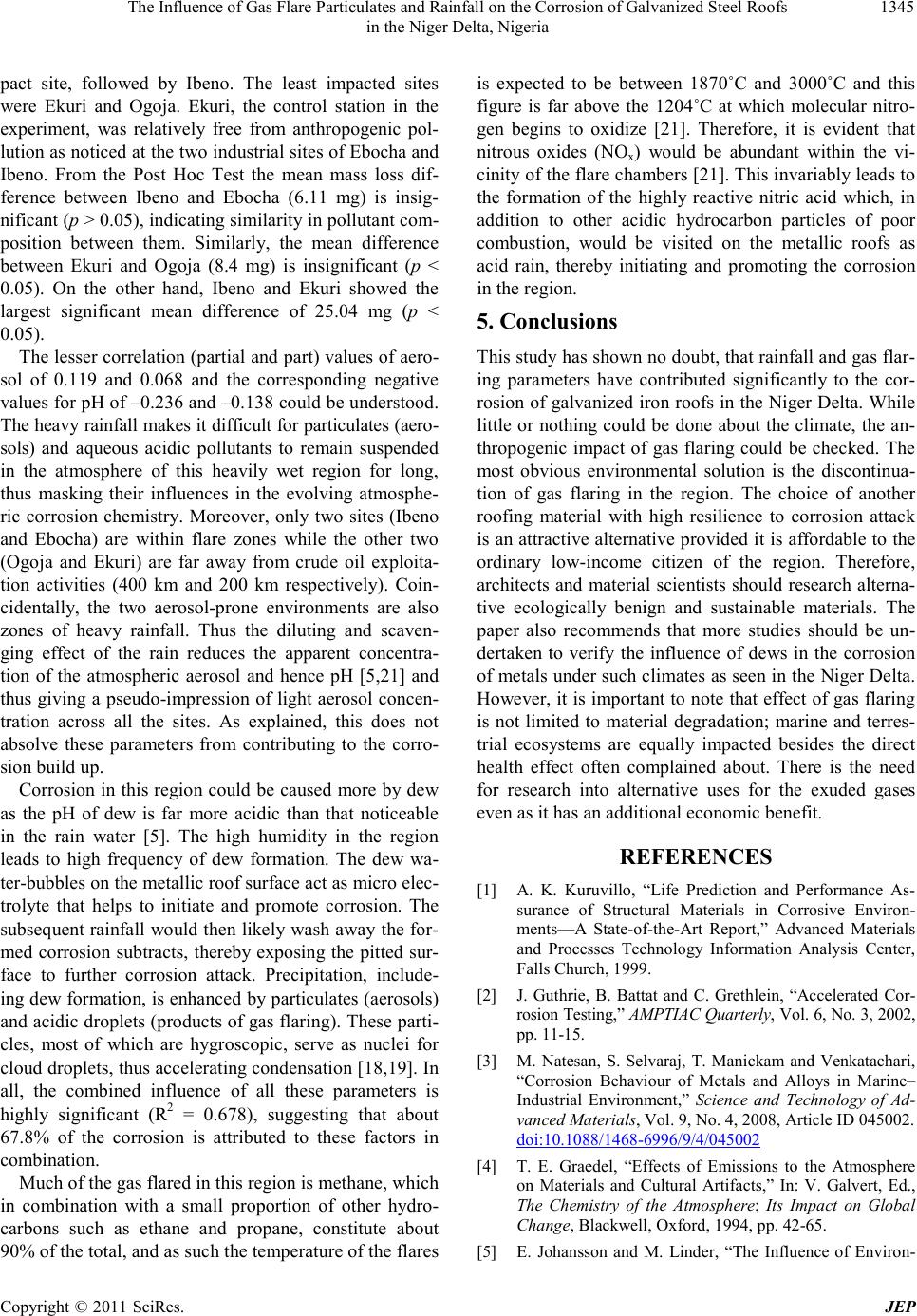
The Influence of Gas Flare Particulates and Rainfall on the Corrosion of Galvanized Steel Roofs 1345
in the Niger Delta, Nigeria
pact site, followed by Ibeno. The least impacted sites
were Ekuri and Ogoja. Ekuri, the control station in the
experiment, was relatively free from anthropogenic pol-
lution as noticed at the two industrial sites of Ebocha and
Ibeno. From the Post Hoc Test the mean mass loss dif-
ference between Ibeno and Ebocha (6.11 mg) is insig-
nificant (p > 0.05), indicating similarity in pollutant com-
position between them. Similarly, the mean difference
between Ekuri and Ogoja (8.4 mg) is insignificant (p <
0.05). On the other hand, Ibeno and Ekuri showed the
largest significant mean difference of 25.04 mg (p <
0.05).
The lesser correlation (partial and part) values of aero-
sol of 0.119 and 0.068 and the corresponding negative
values for pH of –0.236 and –0.138 could be understood.
The heavy rainfall makes it difficult for particulates (aero-
sols) and aqueous acidic pollutants to remain suspended
in the atmosphere of this heavily wet region for long,
thus masking their influences in the evolving atmosphe-
ric corrosion chemistry. Moreover, only two sites (Ibeno
and Ebocha) are within flare zones while the other two
(Ogoja and Ekuri) are far away from crude oil exploita-
tion activities (400 km and 200 km respectively). Coin-
cidentally, the two aerosol-prone environments are also
zones of heavy rainfall. Thus the diluting and scaven-
ging effect of the rain reduces the apparent concentra-
tion of the atmospheric aerosol and hence pH [5,21] and
thus giving a pseudo-impression of light aerosol concen-
tration across all the sites. As explained, this does not
absolve these parameters from contributing to the corro-
sion build up.
Corrosion in this region could be caused more by dew
as the pH of dew is far more acidic than that noticeable
in the rain water [5]. The high humidity in the region
leads to high frequency of dew formation. The dew wa-
ter-bubbles on the metallic roof surface act as micro elec-
trolyte that helps to initiate and promote corrosion. The
subsequent rainfall would then likely wash away the for-
med corrosion subtracts, thereby exposing the pitted sur-
face to further corrosion attack. Precipitation, include-
ing dew formation, is enhanced by particulates (aerosols)
and acidic droplets (products of gas flaring). These parti-
cles, most of which are hygroscopic, serve as nuclei for
cloud droplets, thus accelerating condensation [18,19]. In
all, the combined influence of all these parameters is
highly significant (R2 = 0.678), suggesting that about
67.8% of the corrosion is attributed to these factors in
combination.
Much of the gas flared in this region is methane, which
in combination with a small proportion of other hydro-
carbons such as ethane and propane, constitute about
90% of the total, and as such the temperature of the flares
is expected to be between 1870˚C and 3000˚C and this
figure is far above the 1204˚C at which molecular nitro-
gen begins to oxidize [21]. Therefore, it is evident that
nitrous oxides (NOx) would be abundant within the vi-
cinity of the flare chambers [21]. This invariably leads to
the formation of the highly reactive nitric acid which, in
addition to other acidic hydrocarbon particles of poor
combustion, would be visited on the metallic roofs as
acid rain, thereby initiating and promoting the corrosion
in the region.
5. Conclusions
This study has shown no doubt, that rainfall and gas flar-
ing parameters have contributed significantly to the cor-
rosion of galvanized iron roofs in the Niger Delta. While
little or nothing could be done about the climate, the an-
thropogenic impact of gas flaring could be checked. The
most obvious environmental solution is the discontinua-
tion of gas flaring in the region. The choice of another
roofing material with high resilience to corrosion attack
is an attractive alternative provided it is affordable to the
ordinary low-income citizen of the region. Therefore,
architects and material scientists should research alterna-
tive ecologically benign and sustainable materials. The
paper also recommends that more studies should be un-
dertaken to verify the influence of dews in the corrosion
of metals under such climates as seen in the Niger Delta.
However, it is important to note that effect of gas flaring
is not limited to material degradation; marine and terres-
trial ecosystems are equally impacted besides the direct
health effect often complained about. There is the need
for research into alternative uses for the exuded gases
even as it has an additional economic benefit.
REFERENCES
[1] A. K. Kuruvillo, “Life Prediction and Performance As-
surance of Structural Materials in Corrosive Environ-
ments—A State-of-the-Art Report,” Advanced Materials
and Processes Technology Information Analysis Center,
Falls Church, 1999.
[2] J. Guthrie, B. Battat and C. Grethlein, “Accelerated Cor-
rosion Testing,” AMPTIAC Quarterly, Vol. 6, No. 3, 2002,
pp. 11-15.
[3] M. Natesan, S. Selvaraj, T. Manickam and Venkatachari,
“Corrosion Behaviour of Metals and Alloys in Marine–
Industrial Environment,” Science and Technology of Ad-
vanced Materials, Vol. 9, No. 4, 2008, Article ID 045002.
do i:10. 1088 /14 68 -69 96/ 9/4 /045 002
[4] T. E. Graedel, “Effects of Emissions to the Atmosphere
on Materials and Cultural Artifacts,” In: V. Galvert, Ed.,
The Chemistry of the Atmosphere; Its Impact on Global
Change, Blackwell, Oxford, 1994, pp. 42-65.
[5] E. Johansson and M. Linder, “The Influence of Environ-
Copyright © 2011 SciRes. JEP